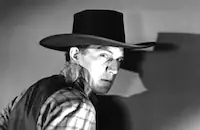Shadows on the Sage
Cast & Crew
Les Orlebeck
Bob Steele
Tom Tyler
Jimmie Dodd
Cheryl Walker
Harry Holman
Film Details
Technical Specs

Synopsis
In Holbrook County, Colorado, bandit Curly leads his men on a series of robberies of the Jackson mining company, during which four successive sheriffs are killed. When no one else wants the job, old-timer Lippy succeeds in getting himself appointed as sheriff, much to the delight of young Johnny Jackson, who worships him. Less pleased are Johnny's father Steve and older sister Doris, but when Lippy assures him that he has sent for his friend, "Tucson" Smith, their fears are quieted. Lippy gets one shipment of Jackson's gold past Curly's gang, which is secretly led by banker John Carson, who has engineered the robberies in order to gain control of the mine. When the gang subsequently attacks the stage on which Lippy and Jackson are carrying the money back to town, they are routed by the arrival of Tucson and his compatriots, "Stony" Brooke and "Lullaby" Joslin, but Lippy is wounded in the arm. Jackson thanks Tucson, Stony and Lullaby, who are known as The Three Mesquiteers, then is escorted to town by Stony and Lullaby while Tucson tracks the gang. When Tucson reaches the hideout, he is captured by Carson and the men, who are amazed by his resemblance to Curly. Carson orders Curly to take Tucson's place and tells his henchmen to keep Tucson prisoner. Curly then joins Stony and Lullaby at the Jackson ranch, where he is barely able to keep up his impersonation of Tucson, but Johnny is delighted to have the Mesquiteers for company. Later that night, Curly is stealing money from Steve's safe when Johnny enters the room and sees the bandit struggling with his father. Steve is shot during the fight and Curly escapes. Stony and Lullaby are greatly upset when Johnny, believing that Curly is Tucson, claims that Tucson is responsible for Steve's death, but they can do nothing. Lippy is forced to step down as sheriff and vows to track down Tucson. While Lippy looks for Tucson, the angry townspeople try to lynch Stony and Lullaby, but the two Mesquiteers escape and go in search of their friend. Carson goes to the gang's hideout, to which Curly has returned, and orders the men to let the posse chasing the Mesquiteers find Tucson. Just then, Lippy reaches the hideout, but he also is captured. The gang is about to throw Lippy and Tucson off a cliff when Stony and Lullaby find them and help them escape. After retrieving the money, Stony sends Lippy and Curly to Doris before she signs the ranch over to Carson, then chases the rest of the gang with Lullaby and Tucson. At the ranch, Doris and Johnny refuse to believe that Curly is not Tucson until he escapes and is chased by the Mesquiteers, who have rounded up the other bandits. Curly is killed when the wagon he is driving overturns, and later, the Mesquiteers wave goodbye to Doris and Johnny as they leave for other adventures.

Director
Les Orlebeck
Cast

Bob Steele

Tom Tyler
Jimmie Dodd
Cheryl Walker
Harry Holman

Bryant Washburn

Griff Barnett

Freddie Mercer
Tom London

Yakima Canutt
Eddie Dew
Burr Caruth
Fred Burns
Johnnie Morris
Frank Brownlee
Bill Nestell
Jack Rockwell
Rex Lease
Betty Farrington
Crew

Film Details
Technical Specs

Quotes
Trivia
Notes
The opening title card reads: "Republic Pictures presents The Three Mesquiteers in Shadows on the Sage," followed by pictures of Bob Steele, Tom Tyler and Jimmie Dodd with their names and character names superimposed. This was the first "Three Mesquiteers" film in which Jimmie Dodd appeared. He replaced Rufe Davis as "Lullaby" Joslin. Modern sources include the following actors in the cast: Horace B. Carpenter, Curley Dresden and Pascale Perry. For more information on the series, consult the Series Index and the entry for The Three Mesquiteers (see AFI Catalog of Feature Films, 1931-40; F3.4617).












